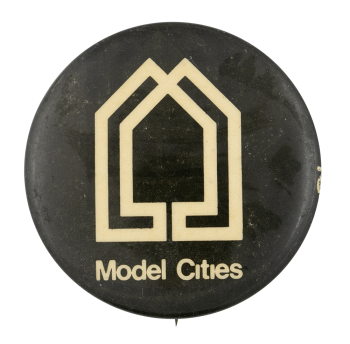| Category | |
|---|---|
| Additional Images | |
| Sub Categories | |
| Text on Button | Model Cities |
| Image Description | White illustration of buildings over white text on a black background |
| Curl Text | EMRESS SPECIALTY CO NEW YORK, N.Y. 10010 |
| Back Style | |
| The Shape | |
| The Size | |
| The Manufacturer | |
| Additional Information | In 1966, the United States Congress passed the Demonstration Cities and Metropolitan Development Act, which began the federal Model Cities Program, which was administered by the Department of Housing and Urban Development. Intended to address the growing problems of poverty and physical and economic blight in many of the nations’ cities, the program awarded funding to cities to make plans to improve life in designated “Model Neighborhoods.” Although it was a federal program, local participation was emphasized. In fact, the program got its name because it was meant to create a “model” relationship between federal, local, and community actors. When Richard Nixon became president in 1969 and advocated for “new federalism”, the program transformed to align with Nixon’s formulaic revenue-sharing model. After his 1972 reelection, Nixon reevaluated the federal aid flowing to cities. He ended funding for the Model Cities program in 1973. |
| Sources |
Landis, J. (2012). Model Cities Program. In A.T. Carswell (Ed). The Encyclopedia of Housing, Second Edition (Vol. 2, pp. 458-461) SAGE Publications, Inc. Klemek, C. (2007). Model Cities. In D. Goldfield (Ed.), Encyclopedia of American Urban History (Vol. 2, pp. 484-486). Thousand Oaks, CA: SAGE Reference. Hetzel, O. & Pinsky, D. E. (1969, May). The Model Cities Program. Vanderbilt Law Program. 22(4). |
| Catalog ID | AD0911 |


